Framing statement
Site Specific; “A theatrical performance, whatever its genre, its physical event occupying a certain space and certain duration” (McAuley, G, 2000, p126) Going to a place for the first time, “In which the reader is invited to undertake research at a particular location: to develop narrative from such enquiry and to engage in a practical and physical exploration at such place” (Pearson, M. 2010 p, 83) Having the Drill Hall, as our performance space, allowed us to explore the many different people at many different periods of time. This specific site has enabled us to examine numerous possibilities for a performance, researching into the history of the Drill Hall, comparing them with ones of today.
Initial thoughts-
After careful consideration on which room we would like to perform in, my group chose The Cosker room. Not only was this on of the bigger rooms, reaching “Approx. 7.2m x 15.9m” (Drill hall, 2016) It was also a room that could be adapted into many different things, “Sprung wooden dance floor – ideal for dance workshops/rehearsals, auditions, castings etc… Can also be used for mid-scale meetings, training and workshops.” (Drill hall 2016) Towards the beginning of our search we found the idea of rehearsals interesting, having a room that housed people from different ages and walks of life, being brought together to do the same thing. After more research, and asking at the front desk of the Drill Hall for help, we realised they were in fact was still accommodating dance classes for the elderly. This information lead us on to our first idea, ‘Three piles’. Each pile would contain shoes from a specific era, with accompanying music to go along. After finding Janet Cardiff, a well-known site specific artist who focuses her work on around sound, we decided to take inspiration, using speakers, much like her performance ‘Audio walks’. This style of performance immerses the audience member, layering and adding texture to the performance, allowing the audience to experience it through both seeing and hearing communications. The audience would experience three different types of music playing at the same time, influenced by Cardiff’s 40 Part Motet, alongside a connecting piles of shoes. One pile containing 40’s style shoes, one, Military boot (representing the fact the Drill Hall used to be a military training base) and finally, modern shoes to show that it accommodates today’s generation as well.
Although this piece was thought out and did link to the history of the drill hall, we were unsure of what we would be doing in the space. We didn’t know whether to use interviews from people of the era and use that in a one to one style performance or not. After discussing with the group our next plan was to wait and see if we could get more information from the Lincoln archives. Much to our disappointment there was minimal information on the dances and our idea was becoming more distanced from site specific and just becoming a devised performance. Due to this we took the time we had left in the archives to search for a new lead, finding an interesting document containing the life of Joseph Ruston.
Analysis of process
Joseph Ruston –
In 1889 Ruston, Proctor & Co accountants certified that over the previous 7 years the company had made an average profit of £50,000 per year. The same year Joseph Ruston converted Ruston, Proctor & Company into a public company, for this he received £465,000 and he rewarded his most senior employees with shares to the value of £10,000. In the same year Ruston paid for a new Drill Hall to be built. It was to be built on Broadgate and house military training. The workers of Ruston’s previous business were unimpressed with the next hall seen as they had previously asked for a pay rise which Ruston denied and said
“I hope you’ll let me get bread and cheese out of my business!” After this Joseph Ruston was nicknamed ‘Mr Bread and Cheese and inevitably the new building became known as ‘Bread and Cheese Hall’. Although we knew little about Ruston and his workers, the quote was such a direct link to the drill hall it was hard to ignore.
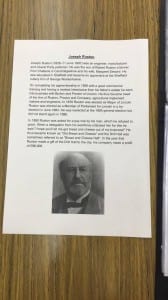
Initially our idea was to build the drill hall out of bread and cheese to symbolise Ruston’s involvement, however after many attempts we found that building a sculpture that not only looked like the drill hall, but by only using these materials would be too difficult. We then decided that we could cut the bread and cheese and lay it down creating a floor plan. When cutting the bread into strips it was brought to our attention that each piece could signify the soldiers who trained there, collaborating would enable us to have a reason for the specific size of our piece, and would allow us to draw more facts to enhance the bond between both space and idea.
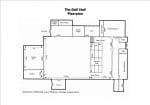

(Goddard, 2016)
Although to us this idea seemed strong, from an outsider’s opinion, the floor plan could have been anything we created could have been anything. The soldiers weren’t recognised as soldiers like we had anticipated. It also came to our attention that the idea had little room for development, and could not be easily adapted.
Because of this our attention was drawn back to the quote. That fact Ruston used his business an excuse to benefit himself rather than his workers, opened our minds to the idea of business, and using bread and cheese as stimulus for a business of our own. As a result of one of our previous ideas (three piles of shoes) we decided to resort back to the idea of piles, knowing this would be aesthetically pleasing; three performers, and three piles. We chose to add flour to the piece, showing another raw material, which is also linked closely with bread, but also is notably different to the other two.
Turning these raw materials into our own business was a tough process, we were confused on how to incorporate the three, or whether to spate them in different sections of the room, allowing audience members to walk round willingly. As a group and with an outsider’s perspective, we decided to sit side by side, not interacting with each other, however still looking like a unit or trio. This would unite the materials and give a cleaner finish as a whole.
After researching into live artists and site specific performers who use natural/food products, we can across Antony Gormley. An artist who had previously used bread in his own work. Antony talks about how the bread was seen as a natural source, however there was nothing natural about it. The wheat was bleached and slices were pre-cut, showing the workmanship and unnecessary routine the product goes through, in turn taking it away from its original state. ‘It’s square, it’s been divided, its metonymy is now of absolute 8mm thick slices’.(Gormley, 2015)
http://www.tate.org.uk/context-comment/video/tateshots-antony-gormley-breaking-bread
Tateshots: Antony Gormley: Breaking Bread (2015)
During the interview with Gormley, references to industrialization are brought up, making comments to modern society, and how it is becoming rigid and unnatural. We wanted to incorporate this in our piece, with including a structured approach with the business like element.
Cutting the bread and cheese seemed like the best option to begin the process of deterioration, while still keeping the element of work and business going throughout.



However flour was the odd one out, leaving us with the idea of collect the flour, moving it from a pile on the floor to smaller and more precise piles in bowls. These actions were successful and could be adapted each time. As shown in the pictures above, when regarding the floor plan for our earlier idea we explored the different types of bread, looking into the thickness and quality (in regards to brand and price) enabling us to choose our preferred loaf. We decided that the supermarket own bread was better for our performance as we could incorporate the offcuts (as seen in the third picture) to represent the fallen soldiers, who trained at the drill hall. Although this idea had been developed since then, it was still crucial for us to research the type of bread cheese and flour, enabling us to be cost effective where need be.
Bringing in the fourth element-
Now we had a clear idea of what we were doing in the performance the group decided to develop the piece more by adding in other elements. Firstly we started adding water to the flour, turning it into a dough, exploring a new material being made. We then looked at the texture of the cut cheese, deciding to grate half of it to see the contrast between the two, and finally we looked into rolling/ flattening the bread, focusing on its denseness, making it easy to sculpt and manipulate. All of these things changed the performance, questioning the structured business-like manner we had intended upon.
Adding water, and kitchen equipment help showcase the deterioration of the natural products, in turn, allowing us to learn and express the idea of industrialization. Creating a durational performance that showed the development from the shelf product to something almost unrecognisable was now our aim. As a result of using numerous kitchen products we looked at adding a table full, showcasing them in a similar way to how Marina Abramović does.
Abramović has been the latest artist to influence our piece, allowing us to develop ideas and create another dimension to the piece. We found her performance ‘Rhythm O’ (1974) intriguing, using the element of danger to draw us as audience members in.
“Of the 72 items laid out for Abramović’s performance, some were chosen with pleasure in mind, whereas others definitely suggested pain.” (Richards, M, 2009, p89) Audience members could choose which ever they wanted and use it on her body, almost as if she is the blank canvas. This began with items that could do no harm, which then changed, ended up with knives and guns. Not only was this concerning, it also created the idea of the unknown. She herself not know what was going to happen, the onlookers were in the dark as well. Abramović was prepared to get seriously injured or even die for her performance, showing the drastic measures that herself, as a performer was willing to accept. Although we didn’t want the audience members to participate unlike Marinas work, we wanted to show an orderly structure to our work still relating to the idea of business, this in turn allowed us to use numerous items as the piece went on, creating more room for the corrosion of our products. We kept the element of danger, using objects such as sharp knives and graters to show how influenced by Abramović work we were yet incorporating it in our own way to enhance our own piece of art.
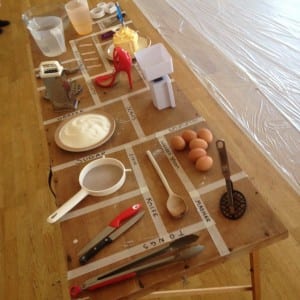
By reason of the drill hall kindly letting us use the space from the hours of 12pm-5pm, the group decided to perform our durational peice for 3 hours, (2pm-5pm). By choosing the time scale of three hours kept with the original aesthetic of the piece, relating to the three performers and three materials. This not only gave us time to structure our performance, it also opened a window for development. Having three hours meant that we could each take it in turns with the materials, swapping on every hour. The first hour being regimented, the second starting to show the elements of deconstruction, and the third allowing us to completely change the products, consenting to a sabotage like feel. Not only was the third hour the main form for deconstruction, it also allowed us as performers to interact with the materials, experimenting with the flour in the air, the dough between our toes and the cheese on our arms. We had pushed the products so far from the norm it was hard to tell which pile was which anymore, resulting in success for the group.
Clothing-
As a group we knew that we wanted to look like a collective, making sure we were in similar clothes that enhanced our performance. “Clothing is emblematic, and can be identified as a uniform.”(Howell, A. 1999, p15) After much deliberation over the idea of skirts and dresses, we decided that black trouser and black tops would be most appropriate seen as we were sat on the floor a lot. We decided to go for black to contrast the white flour, white bread and light coloured cheese making them stand out and be the main ‘ingredient’ of the performance.
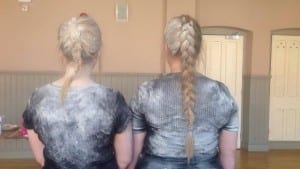
We also choose to wear hair nets and plastic aprons to continue the theme of business. (Like in any bakery hair nets are key for cleanliness) the plastic aprons inspired our choice in flooring, giving us the idea of using plastic dust sheets to protect the wooden floor, not only to merge with the aprons, but also to save from the clean-up at the end of the piece. We choose plastic because it is a manmade material, both contrasting and conforming to our outlook of the performance. It contrasted because the bread, cheese and flour were technically natural materials, however we were turning them into something unrecognisable, a product of our own creation.
Performance evaluation
After performing, I think that the overall point was made. The link to the drill hall and our performance was apparent and the way in which it was performed was as planned. A few days before the performance we decided to add in the date when the drill hall was built, we knew we would be constructing this out of the materials, but was unsure of how it would look. After careful deliberation and planning we decided that we would do it, using myself as a guide to the sizing.
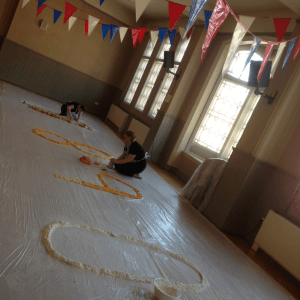
After looking back on the performance, I believe we could have changed the layout of the bread cheese and flour. Both bread and cheese began by being cut, yet flour scoped. If as a group we had stopped to acknowledge this we could have had the flour in the middle, making the performance more symmetrical.
If we were to rethink any part of our performance, it would be the involvement with the audience. It wasn’t made clear to them that the performance was durational, and we should have advised them to come back every hour to see the change and destruction caused. I would also make a note of the table of objects, being for the use of the performers and not audience members. During the first hour an audience member picked up the tongs, come to the pile of bread, taking one slice and laying it to the left (audience perspective) of the pile, she then went on to collect two slices of cheese and lay them on top of the bread, forming a sandwich. As performers we had discussed our communications with the audience members and decided to ignore then, in turn this meant that we were unable to correct the situation, and wondered if other audience participants would follow suit. Luckily for the group they didn’t, meaning our performance continued as normal. After contemplating the reasoning behind this act, it was brought to our attention that she could have had involvement with Marina Abramović’s pieces in the past, showing that our table replicated hers. Having an audience member create a new fragment for our performance without us being aware beforehand was disconcerting. As a group we had to decide whether to include it in our process of breakdown. To leave it could draw reference to an ‘offcut’ in a factory, (part of material that is of no worth), however the decision was to be left up to the performer on that ‘station’ at the time, who decide to include it, merging both our work and audience work together.
Word count 2640.
Bibliography-
Cain (2016).
Chattaway (2016).
Goddard (2016).
Howell, A. (1999) The analysis of performance art: A guide to its theory and practise. 2nd edn. Amsterdam: Harwood academic.
Lincoln Drill Hall (2013) Lincoln Drill Hall: Room Hire [online] Lincolnshire: Drill Hall.
Available from http://www.lincolndrillhall.com/room-hire/room-hiring-facilities/
[Accessed 1th May 2016].
McAuley, G. (2000) Space in performance: Making meaning in the theatre (theatre: Theory/text/performance). United States: The University of Michigan Press.
Pearson, M. (2010) Site-specific performance. Houndmills, Basingstoke, Hampshire: Palgrave Macmillan.
Pinchbeck (2016).
Richards, M.P. (2009) Marina Abramović. London: Routledge.
Tate (2015) Tateshots: Antony Gormley: Breaking Bread [online] London: Tate.
Available from http://www.tate.org.uk/context-comment/video/tateshots-antony-gormley-breaking-bread
[Accessed on 10th May 2016].